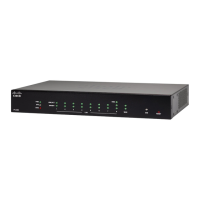Preview the IPv6 address.Preview
Select the appropriate interface identifier.Interface
Identifier
• Disabled – Disables the DHCP IPv6 server on VLAN.
• Server
• Lease Time – Enter a time value of 5 to 43,200 minutes. Default is 1440 minutes (equal
to 24 hours).
• Range Start and Range End – Enter the start and end IP address range that can be
assigned dynamically.
• DNS Server – Select to use DNS server as proxy, or from ISP from the drop-down list.
DHCP Type
Step 6 Click Apply.
Assign VLANs to Ports
Traffic on the port can be tagged by applying a specified VLAN. This tagging can help in differentiating the traffic and
forwarding it. There are only 16 VLANs in the system and only one VLAN on WAN in the system can be configured.
To assign a VLAN to a port, enter the following information:
Step 7 Select the appropriate VLAN ID.
Step 8 Click Edit to assign a VLAN to a LAN port and specify the following information:
• Untagged – Makes the port untagged from the selected VLAN. If the port is in Access or Trunk mode, the Default
VLAN is automatically excluded when the port joins the VLAN as Untagged. Select Untagged from the drop-down
list to untag the port.
• Tagged – Includes the port as a member for the selected VLAN and packets from this port destined to the chosen
VLAN has the packet tagged with the VLAN ID. Select Tagged from the drop-down list, to include the port as a
member for the selected VLAN. Packets sent from this port destined to the chosen VLAN has the packets tagged
with the VLAN ID. If there are no untagged VLANs on a port, the interface automatically joins the VLAN1.
• Excluded – Select Excluded from the drop-down list, to exclude the port from the selected VLAN.
Step 9 Click Apply.
Option82 Settings
DHCP setup configures the DHCP server for relay or Option82 (DHCP relay agent information option) for
LAN clients to obtain IP addresses. DHCP server maintains local pools and leases. It also allows LAN clients
to connect to a remote server for obtaining IP address.
Option82 enables a DHCP relay agent to include information about itself when forwarding client-originated
DHCP packets to a DHCP server. The DHCP server can use this information to implement IP addressing or
other parameter-assignment policies.
To configure the Option82 settings, follow these steps:
RV260x Administration Guide
59
LAN
Option82 Settings

